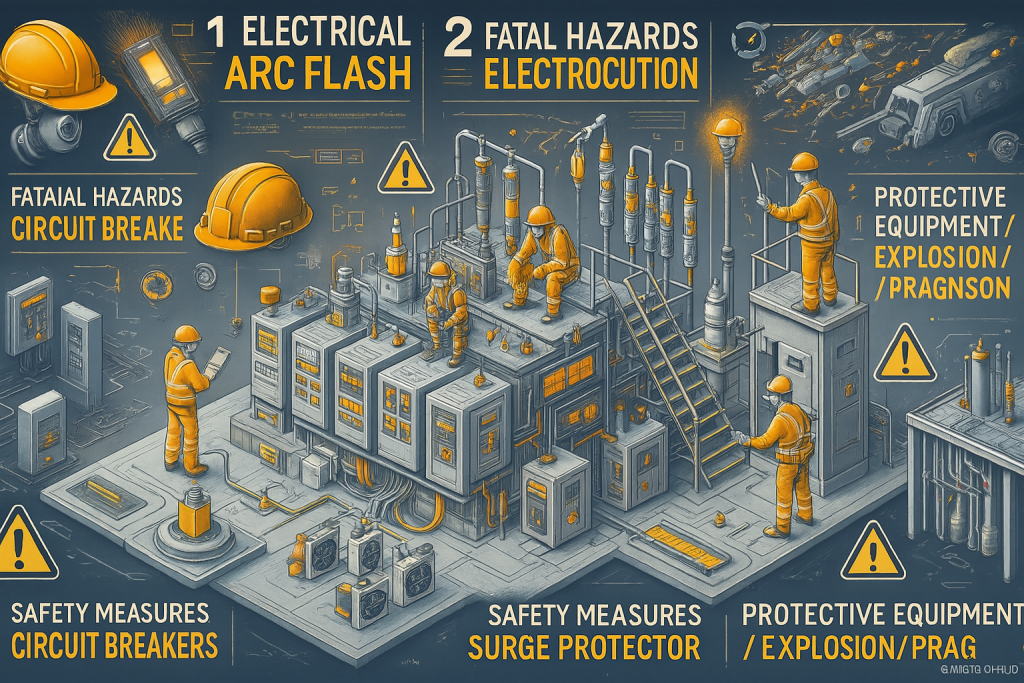Safety Considerations in Industrial Instrumentation & Electrical Systems
Industrial instrumentation and electrical systems form the foundation of modern manufacturing, power generation, and process industries. These systems control, monitor, and protect everything from automated assembly lines to power distribution networks. However, they often operate in environments that expose workers and equipment to high voltages, complex machinery, flammable substances, and hazardous conditions. Safety is not just a regulatory requirement—it’s a critical factor for protecting human lives, ensuring equipment reliability, and maintaining uninterrupted production.

Why Safety is Critical in Industrial Instrumentation & Electrical Systems
Safety considerations in industrial electrical and instrumentation systems go beyond preventing accidents. A strong safety culture ensures long-term operational stability and protects both people and assets.
- Prevents Workplace Accidents – Electrical hazards, arc flashes, and malfunctioning instrumentation can lead to burns, electrocution, or even fatalities.
- Ensures Equipment Reliability – Preventive maintenance, inspections, and calibration reduce equipment breakdowns and extend operational life.
- Minimizes Downtime & Financial Losses – Accidents can halt production for hours or days, resulting in significant losses.
- Ensures Regulatory Compliance – Compliance with OSHA, IEC, IEEE, NFPA, and ISO standards avoids penalties and legal issues.
- Protects the Environment – Safety measures prevent fires, chemical leaks, and emissions that can damage the environment.
Common Hazards in Industrial Instrumentation & Electrical Systems
Recognizing hazards is the first step toward eliminating them. Below are the most common risks:
- Electrical Shock & Electrocution – Direct contact with energized conductors can be fatal without proper insulation, PPE, and lockout-tagout (LOTO) procedures.
- Arc Flash & Arc Blast – Short circuits can generate extreme heat, high-pressure waves, and blinding light, causing burns or hearing damage.
- Fire & Explosions – Overheating, poor wiring, and electrical faults in hazardous zones can ignite flammable gases or dust.
- Instrument Malfunction – Faulty sensors or controllers may produce inaccurate readings, leading to unsafe operational decisions.
- Static Electricity & Electrostatic Discharge (ESD) – Discharges can damage sensitive electronics or ignite volatile substances.
Key Safety Measures & Best Practices
- Lockout-Tagout (LOTO) – De-energize and isolate electrical equipment before servicing to prevent accidental startup.
- Personal Protective Equipment (PPE) – Use arc-rated clothing, insulated gloves, face shields, and dielectric footwear.
- Grounding & Bonding – Properly connect all conductive components to prevent shock and reduce static buildup.
- Regular Calibration – Ensure all measuring devices are calibrated to maintain accuracy and safety.
- Explosion-Proof & Intrinsically Safe Devices – Use certified equipment in hazardous areas to prevent ignition.
- Thermal Imaging & Infrared Inspections – Detect overheating components before they fail.
- Routine Safety Audits – Conduct monthly or quarterly audits to identify potential hazards.
Safety Checklist for Industrial Facilities
- ✅ All equipment labeled with voltage ratings and hazard warnings
- ✅ PPE available and in good condition
- ✅ Lockout-Tagout procedures documented and enforced
- ✅ Fire extinguishers and suppression systems in place
- ✅ Regular training sessions for all staff
- ✅ Circuit breakers and surge protection installed
- ✅ Proper cable management to avoid trip hazards
Case Study 1: Preventing Arc Flash in a Petrochemical Plant
A petrochemical facility experienced repeated tripping of a high-voltage breaker. Infrared inspection revealed deteriorating insulation on the busbars. The plant replaced the affected section, installed arc-flash detection relays, and introduced mandatory PPE requirements. Result: zero arc flash incidents in the following two years.
Case Study 2: Avoiding Instrumentation Failure in a Pharmaceutical Plant
In a GMP-certified pharmaceutical plant, temperature sensors in a reactor vessel failed due to moisture ingress. This caused a batch rejection worth $250,000. Post-incident measures included sensor housing upgrades, more frequent calibration, and humidity monitoring. The changes eliminated similar failures for 18 months.
Relevant Safety Standards & Regulations
- OSHA 1910 Subpart S – Electrical safety standards for general industry.
- NFPA 70E – Electrical Safety in the Workplace, including arc flash protection.
- IEC 60204 – Electrical equipment safety for machinery.
- IEEE 1584 – Arc-flash hazard analysis and calculation guidelines.
- ISO 13849 – Safety of control systems for machinery.
Frequently Asked Questions (FAQs)
Q1: How often should electrical safety training be conducted?
A: Annually, with additional sessions when new equipment or procedures are introduced.
Q2: What is the difference between grounding and bonding?
A: Grounding connects equipment to earth to prevent shock hazards, while bonding ensures all conductive parts are at the same potential.
Q3: Why is arc flash analysis important?
A: It determines the incident energy levels and PPE category needed to safely work on equipment.
Q4: What is the role of instrumentation in safety?
A: Instruments monitor parameters like temperature, pressure, and flow—alerting operators before unsafe conditions occur.
Q5: How do you select explosion-proof equipment?
A: Choose devices certified for your specific hazardous area classification (e.g., ATEX, IECEx).
Q6: Can static electricity really cause explosions?
A: Yes, in environments with flammable gases or dust, static discharge can be an ignition source.
Industrial instrumentation and electrical systems are critical for modern operations, but their hazards must never be underestimated. By adopting proven safety measures, staying compliant with international standards, and continuously training staff, facilities can significantly reduce risk. A proactive safety culture not only prevents accidents but also improves efficiency, reduces downtime, and enhances the company’s reputation.
